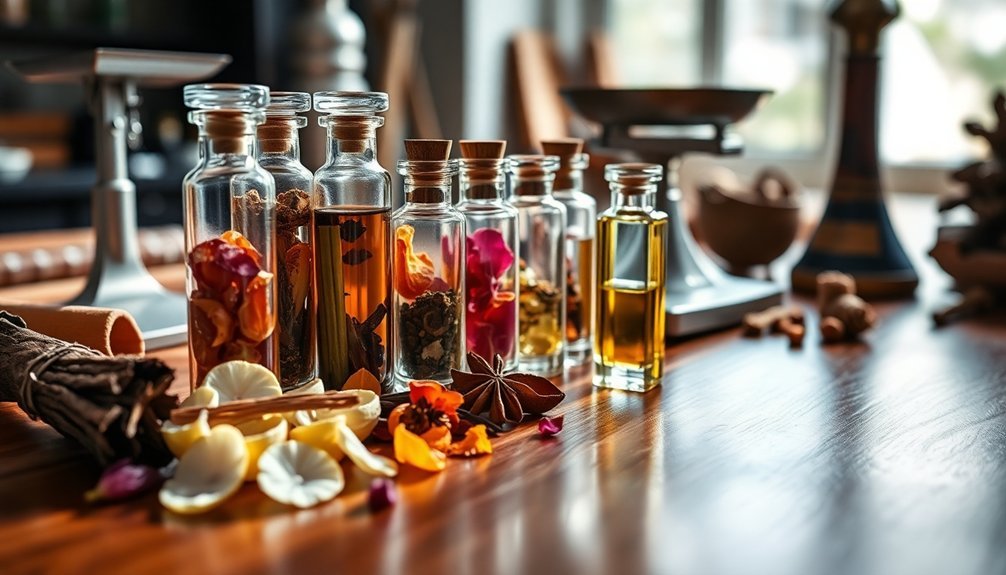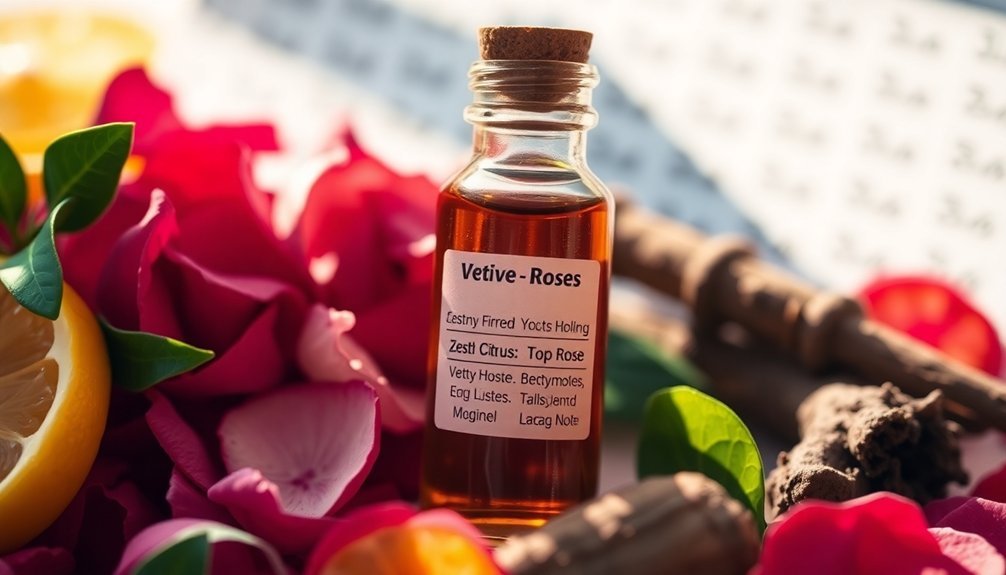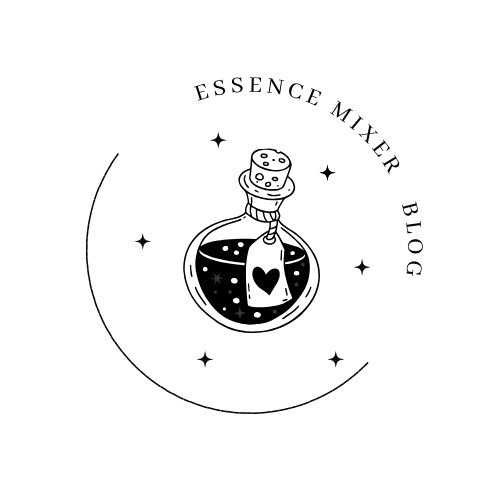A balanced perfume formula relies on carefully layering three distinct note categories in the right proportions. You'll want to use 20-40% top notes for initial freshness, 50-75% middle notes for the core character, and 5-10% base notes for lasting depth. Focus on blending bright citruses, prominent florals, and rich woods while maintaining a weighted vapor pressure around 0.01 mmHg. Understanding these ratios and note interactions reveals the secrets of professional perfumery.
The Science Behind Fragrance Note Layering

When you examine the artistry of perfumery, you'll find that creating a balanced fragrance relies on the precise layering of three distinct note categories.
The science behind this layering follows a time-based evolution, where each note serves a specific purpose in the fragrance journey.
Your initial encounter starts with top notes, comprising 20-40% of the formula. These volatile ingredients create that first burst of freshness but fade within 30 minutes.
As they dissipate, the middle notes emerge, making up 50-75% of the composition and acting as the fragrance's heart for several hours.
Finally, base notes, though only 5-10% of the formula, anchor the entire composition with their slow-evaporating molecules.
This scientific interplay between notes guarantees your fragrance tells a complete olfactory story.
Understanding The Three-Tier Perfume Structure
While master perfumers rely on artistic intuition, they also follow a precise architectural approach known as the three-tier perfume structure.
You'll notice how your fragrance evolves throughout the day, starting with vibrant top notes that quickly captivate your senses, shifting to the heart of middle notes that bridge the composition, and finally settling into lasting base notes that leave a memorable impression.
- Top notes make up 20-40% of the formula, featuring citrus and herbs that evaporate within 30 minutes
- Middle notes comprise 50-75%, incorporating florals and spices that create the fragrance's core character
- Base notes account for 5-10%, using woody and musky elements for lasting depth
- The seamless change between layers guarantees your perfume doesn't fall flat or disappear too quickly
Proportion Secrets For Blending Notes

Three key ratios define the art of perfume blending, forming the foundation of a well-balanced fragrance.
You'll want to start with your middle or heart notes, which should comprise 50-75% of your formula, as they establish the fragrance's core character and depth.
Next, incorporate your top notes at 20-40% of the blend. These fragrance notes create that essential first impression and provide the initial burst of freshness.
Finally, add your base notes sparingly, using just 5-10% to anchor the scent and guarantee longevity without overpowering the composition.
While you can experiment with these proportions to create unique combinations, sticking to these ratios will help you achieve a harmonious evolution of scent, where each layer smoothly shifts into the next, creating a well-rounded perfume.
Essential Ingredients For Each Note Category
Understanding the essential ingredients for each note category starts with recognizing how specific materials contribute to a perfume's character. When you're crafting a fragrance, you'll need to select ingredients that work harmoniously across all perfume notes while maintaining their distinct roles.
- Top notes rely on bright citrus elements like bergamot and lemon to create that vital first impression.
- Heart notes feature prominent florals such as rose and jasmine, often enhanced with spicy accents like cinnamon.
- Base notes depend on rich materials including sandalwood, vanilla, and musk for lasting power.
- Synthetic ingredients complement natural materials across all note categories to improve stability.
You'll achieve the best results by combining these ingredients thoughtfully, ensuring each note category fulfills its role in the fragrance's evolution from initial spray to final dry-down.
Measuring And Balancing Vapor Pressure

To create a well-balanced perfume formula, you'll need to calculate the vapor pressure ratios of your ingredients, typically aiming for a weighted average around 0.01 mmHg.
You can test your formula's components by measuring their individual volatility levels and adjusting the proportions until you achieve the desired balance between quick-evaporating top notes and longer-lasting base notes.
When pressure testing your mixture, guarantee that no single ingredient's vapor pressure overwhelms the others, as this will help maintain a harmonious progression of scent from start to finish.
Calculating Ideal Vapor Ratios
Creating a perfectly balanced perfume requires mastering the delicate art of vapor pressure ratios, where the total vapor pressure should hover around 0.01 mmHg for ideal skin longevity.
You'll need to carefully balance the vapor pressure of each ingredient to achieve a harmonious blend that evolves beautifully over time.
- Base notes with low vapor pressure provide lasting power and anchor the fragrance
- Top notes with higher vapor pressure create immediate impact and first impressions
- Middle notes (50-75%) form the heart of your composition
- Vapor pressure calculations help predict how your scent will diffuse
To create a well-rounded fragrance, you'll want to maintain the right proportions: 20-40% top notes for initial impact, 50-75% middle notes for body, and 5-10% base notes for longevity.
Understanding these ratios helps you predict how your fragrance will perform throughout its lifecycle.
Balancing Material Volatility Levels
A balanced perfume formula hinges on mastering material volatility levels, which directly impact how your fragrance evolves on the skin.
You'll need to target an overall vapor pressure of around 0.01 mmHg for your concentrate, carefully measuring each ingredient's contribution to the final blend.
When you're working with top notes that have high volatility, you'll want to balance them with slower-evaporating materials to create a harmonious progression.
Understanding vapor pressure helps you predict how your fragrance will perform over time. By measuring the proportions of each component, you can guarantee your base notes provide lasting power while maintaining the desired scent profile.
This precise balance between fast and slow-evaporating materials is what creates a well-rounded fragrance that delivers an enjoyable experience from first spray to final dry-down.
Pressure Testing Formula Components
While crafting your perfume formula, you'll need to measure and test the vapor pressure of each component to ascertain proper balance.
Understanding how notes in perfumery interact helps you predict how your fragrance reaches the nose over time. When you test vapor pressures, you'll see how base notes like Sandalwood stay longer on the skin while more volatile components evaporate quickly.
- Calculate individual vapor pressures of each ingredient before mixing
- Monitor how different concentrations affect the overall formula's volatility
- Test the interaction between components to prevent unwanted acceleration or suppression
- Track the evaporation timeline to ascertain proper progression from top to base notes
Creating Harmonious Note Transitions

To achieve seamless shifts between fragrance layers, perfumers carefully orchestrate the interaction of top, middle, and base notes.
You'll notice top notes create an immediate impact with bright, citrusy scents that last 15-30 minutes, making a striking first impression. As these fade, heart notes emerge to form the fragrance's core, delivering floral or spicy elements that create a harmonious change between layers.
Your perfume's base notes will surface about 30 minutes after application, providing rich, warm undertones that anchor the entire composition.
This delicate balance guarantees each layer complements the others, with top notes comprising 20-40%, heart notes 50-75%, and base notes 5-10% of the formula.
When properly balanced, you'll experience a seamless evolution from fresh opening to lasting depth.
Natural Vs Synthetic Note Selection
Understanding the balance between natural and synthetic notes forms the cornerstone of modern perfume creation. When you're selecting notes for your fragrance experience, you'll find that both natural materials and synthetic notes serve distinct purposes.
Natural ingredients bring vibrancy and complexity to your scent, while synthetics guarantee consistency and longevity in your formula.
- Natural materials offer rich, multifaceted dimensions that create depth and authenticity
- Synthetic notes provide stability and help maintain consistent scent profiles
- The combination of both types allows for creative expression while guaranteeing wearability
- Your skin's sensitivity should guide the ratio of natural to synthetic components
The key is finding the right balance that matches your desired outcome.
Consider how each note type contributes to the overall composition, keeping in mind that natural complexity and synthetic precision can work together harmoniously.
Testing Your Formula's Note Performance

How your fragrance evolves on skin reveals the true performance of your formula. To evaluate its success, apply the scent and track how top notes fade within the first 30 minutes, giving way to the heart of your composition. Your middle notes should last several hours, creating a smooth shift between the initial burst and lasting base notes, which can persist for six hours or more.
Use a scent wheel to analyze how your notes create harmony within their fragrance families. Pay attention to the volatility of your ingredients – those with high vapor pressure should deliver immediate impact, while low vapor pressure materials provide longevity.
Confirm your middle notes effectively bridge the gap between fresh top notes and deep base notes for a balanced, cohesive fragrance journey.
Frequently Asked Questions
How Do You Make Balanced Perfume?
You'll need to blend 20-40% top notes for initial freshness, 50-75% middle notes for the heart, and 5-10% base notes for longevity. Mix carefully to guarantee harmonious evaporation and lasting scent.
What Is the Ratio of Notes in Perfume?
You'll want to blend your perfume with 50-75% middle notes for depth, 20-40% top notes for initial impact, and 5-10% base notes for longevity. This ratio guarantees a harmonious fragrance evolution.
How Do They Make Perfume Absolutes?
You'll create perfume absolutes by soaking flowers or plants in a solvent to extract their fragrant compounds. Then, you'll evaporate the solvent, leaving behind a concentrated, viscous liquid with intense aromatic properties.
Which Notes Are Strongest in Perfume?
Base notes are your perfume's strongest elements. They'll last the longest on your skin – up to several days – featuring deep, rich ingredients like woody, amber, and musk fragrances for powerful staying power.
In Summary
You'll create balanced perfumes by carefully layering your notes in proper proportions, ensuring top, middle, and base notes complement each other while maintaining ideal vapor pressure ratios. Combining natural and synthetic ingredients strategically helps achieve the desired longevity and sillage. Test your formulations extensively, adjusting the note percentages until you've achieved seamless shifts and harmonious overall scent progression that matches your creative vision.





Leave a Reply